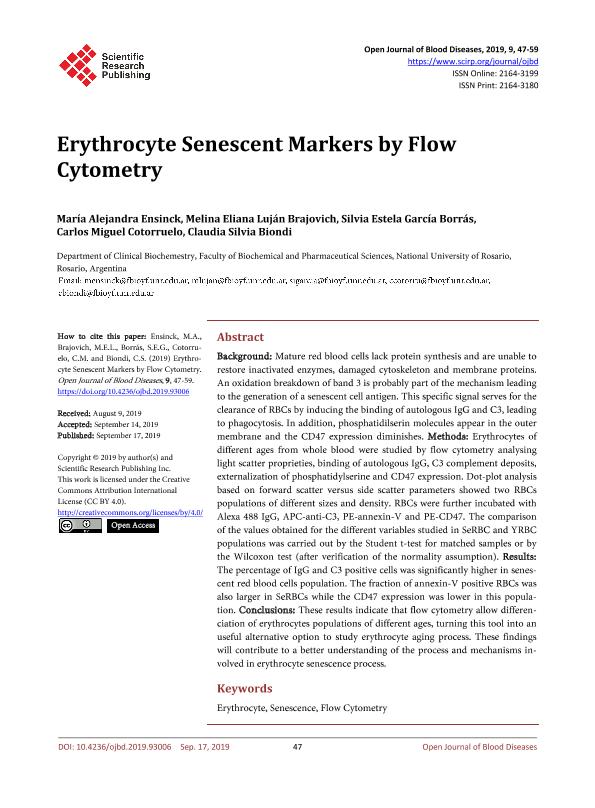Artículo
Erythrocyte Senescent Markers by Flow Cytometry
Ensinck, María Alejandra; Luján Brajovich, Melina Eliana ; García Borrás, Silvia Estela; Cotorruelo, Carlos Miguel
; García Borrás, Silvia Estela; Cotorruelo, Carlos Miguel ; Biondi, Claudia Silvia
; Biondi, Claudia Silvia
 ; García Borrás, Silvia Estela; Cotorruelo, Carlos Miguel
; García Borrás, Silvia Estela; Cotorruelo, Carlos Miguel ; Biondi, Claudia Silvia
; Biondi, Claudia Silvia
Fecha de publicación:
06/2019
Editorial:
Scientific Research
Revista:
Open Journal of Blood Diseases
ISSN:
2164-3180
e-ISSN:
2164-3199
Idioma:
Inglés
Tipo de recurso:
Artículo publicado
Clasificación temática:
Resumen
Background: Mature red blood cells lack protein synthesis and are unable to restore inactivated enzymes, damaged cytoskeleton and membrane proteins. An oxidation breakdown of band 3 is probably part of the mechanism leading to the generation of a senescent cell antigen. This specific signal serves for the clearance of RBCs by inducing the binding of autologous IgG and C3, leading to phagocytosis. In addition, phosphatidilserin molecules appear in the outer membrane and the CD47 expression diminishes. Methods: Erythrocytes of different ages from whole blood were studied by flow cytometry analysing light scatter proprieties, binding of autologous IgG, C3 complement deposits, externalization of phosphatidylserine and CD47 expression. Dot-plot analysis based on forward scatter versus side scatter parameters showed two RBCs populations of different sizes and density. RBCs were further incubated with Alexa 488 IgG, APC-anti-C3, PE-annexin-V and PE-CD47. The comparison of the values obtained for the different variables studied in SeRBC and YRBC populations was carried out by the Student t-test for matched samples or by the Wilcoxon test (after verification of the normality assumption). Results: The percentage of IgG and C3 positive cells was significantly higher in senescent red blood cells population. The fraction of annexin-V positive RBCs was also larger in SeRBCs while the CD47 expression was lower in this population. Conclusions: These results indicate that flow cytometry allow differenciation of erythrocytes populations of different ages, turning this tool into an useful alternative option to study erythrocyte aging process. These findings will contribute to a better understanding of the process and mechanisms involved in erythrocyte senescence process.
Palabras clave:
ERYTHROCYTE
,
SENESCENCE
,
FLOW CYTOMETRY
Archivos asociados
Licencia
Identificadores
Colecciones
Articulos(IDICER)
Articulos de INSTITUTO DE INMUNOLOGIA CLINICA Y EXPERIMENTAL DE ROSARIO
Articulos de INSTITUTO DE INMUNOLOGIA CLINICA Y EXPERIMENTAL DE ROSARIO
Citación
Ensinck, María Alejandra; Luján Brajovich, Melina Eliana; García Borrás, Silvia Estela; Cotorruelo, Carlos Miguel; Biondi, Claudia Silvia; Erythrocyte Senescent Markers by Flow Cytometry; Scientific Research; Open Journal of Blood Diseases; 9; 3; 6-2019; 47-59
Compartir
Altmétricas



